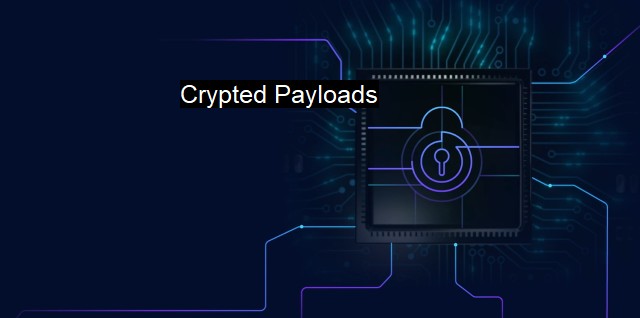What are Crypted Payloads?
Crypted Payloads in Cybersecurity: Understanding the Stealthy Techniques of Advanced Persistent Threats
Crypted Payloads, in the exciting and perpetually evolving realm of cybersecurity and antivirus, demand the utmost attention and action from cybersecurity professionals. Positioned at the forefront of complex cyber attacks, crypted payloads represent a significant threat to information security in a digital world. They are segments of malicious code that have been encrypted, designed to wreak havoc within vulnerable systems.Payload in the digital realm elicited analogues from physical transport; a cargo delivery transported by a vehicle equivalent to data transported across a network. a "payload", as far as cybersecurity terminology as concerned, signifies something inherently more insidious. It can be likened to the delivery of a harmful entity, paralleling a viral outbreak or the deployment of military "payloads", or munitions.
Further refining the term, a 'crypted' payload refers to a payload that has been encrypted or masked to elude detection by standard security measures such as firewalls or antivirus software. Encryption, a process of converting information or data into a code to prevent unauthorized access, is a powerful tool that can be wielded for good, or regrettably, as in cases of crypted payloads, manipulated to nefarious ends.
Crypted payloads exploit the ubiquity of encryption, leveraging its inherent properties to safeguard confidential data from unauthorized parties. Because encryption is a legitimate necessity for digital communication, encrypted data packets are usually considered 'harmless' or benign and ignored by security systems in their operations. As a result, malevolent parties with intentions to infiltrate or compromise systems use this indifference to their advantage, concealing malicious code within encrypted data transfers.
Cybercriminals often use crypted payloads to deliver numerous forms of malicious code, such as Trojans, viruses, ransomware, and malware, that can severely disrupt an organization's operations. The effects range from hijacking user information to encrypting data or files for ransom. Worse, the repercussions of a successful crypted payload include severe financial losses, reputation damage, and disruption to operations.
The prospect of dealing with crypted payloads, understandably, presents a significant challenge to cybersecurity and antivirus professionals. They must strike a fine balance. On one hand, being overly incisive with traffic (through complex decryption or micro-inspection processes, for example) might gravely dent operational efficiencies or breach privacy regulations. On the other, exercising laid-back intrusion detection might open doors to massive cyber threats and security lapses.
The the vast challenges in keeping ahead of these constantly evolving threats, modern security measures like machine Learning/AI and signature-based detection have emerged. Advanced machine learning algorithms and AI are now capable of recognizing obscure patterns or anomalies that may indicate the presence of an encrypted payload. These smart systems aim not only to detect "signatures" of known threats but also to predict and guard against new types of threats, hence providing an added layer of security.
Signature-based detection employs databases of known issues or unique signatures from analyzed crypted payloads, submitting suspicious patterns for rigorous examination in hopes of isolating any concealed threats. While this technique may have its shortcomings, as cybercriminals often modify code signatures to evade detection, it still constitutes a key tool within a layered security defense.
The battle against crypted payloads underscores a complex digital-age struggle. It's a high-stakes see-saw; a cornerstone of a secure digital ecosystem tipping towards concealed threats. The task before cybersecurity experts is to relentlessly strive, adapt, and upgrade their defense mechanisms. Only then can they stand against the challenge of crypted payloads, safeguarding the true weight of our ever-more interconnected digital world.

Crypted Payloads FAQs
What are crypted payloads and why are they used in cybersecurity?
Crypted payloads are malicious software code that has been encrypted in order to evade detection by antivirus software. They are commonly used by cybercriminals to deliver malware payloads, steal sensitive data, or gain unauthorized access to systems.How do crypted payloads infect systems and what are its possible effects?
Crypted payloads can infect systems through various vectors, such as phishing emails, social engineering, or exploit kits. Once installed, it can perform a range of malicious activities, such as stealing data, modifying system settings, or installing other malware. It can also provide unauthorized access to the attacker, allowing them to further compromise the system or network.How can antivirus software detect and prevent crypted payloads?
Antivirus software uses various techniques to detect and prevent crypted payloads, such as signature-based detection, behavioral analysis, heuristics, and machine learning. Signature-based detection compares the code of the payload with known malware signatures, while behavioral analysis monitors the payload's behavior to identify suspicious activity. Heuristics and machine learning use algorithms to identify unknown, suspicious code based on their characteristics.Are there any limitations to using crypted payloads for cybercriminals?
While crypted payloads may provide a way to evade detection by antivirus software, there are still limitations to using it. The encryption process may make the payload larger, which can make it more difficult to distribute and more noticeable. It also requires additional resources and time for the attacker to encrypt and decrypt the payload, and it may not always be successful in evading detection. Additionally, once detected, antivirus vendors can quickly update their software to detect the new encryption method being used.| | A | | | B | | | C | | | D | | | E | | | F | | | G | | | H | | | I | | | J | | | K | | | L | | | M | |
| | N | | | O | | | P | | | Q | | | R | | | S | | | T | | | U | | | V | | | W | | | X | | | Y | | | Z | |
| | 1 | | | 2 | | | 3 | | | 4 | | | 7 | | | 8 | | |||||||